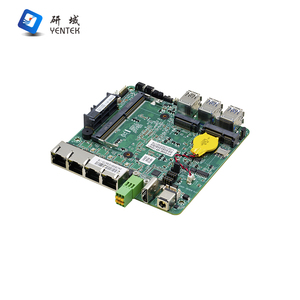
All categories
Featured selections
Trade Assurance
Buyer Central
Help Center
Get the app
Become a supplier

(5874 products available)




















































pfSense Firewalls
The term firewall refers to a network device blocking illegal traffic. An integrated software-hardware platform combining firewall functions with other security tools is called pfSense. This tool runs on a customized operating system based on FreeBSD. It offers multiple ways of protecting systems and is named after the protective barrier around computer networks.
Many types of pfSense firewalls can be used depending on the following criteria:
A pfSense home network typically consists of a router and firewall. The pfSense mini firewall can be used as a small router. It has two Ethernet ports and a serial console for terminal access. Another option is to install pfSense software on a PC with at least two network cards.
Various models of the pfSense software can be used as firewalls. Here are some common features and functions of pfsense firewall:
Since pfSense is versatile and can be customized to suit different needs, it has numerous applications across industries and use cases. Here are the top scenarios of the pfSense:
Network Security and Firewall Protection
The primary purpose of pfSense is to provide robust and reliable security and firewall solutions. It is used by organizations to secure their networks effectively, control access to sensitive data, and protect against insider threats.
VPN and Remote Access
pfSense can be configured to provide secure virtual private network (VPN) access, enabling users to connect remotely to corporate networks safely. This allows organizations to maintain business continuity while ensuring remote workers' data security and privacy protection.
High Availability and Load Balancing
With features like CARP (Common Address Redundancy Protocol) for failover configurations, pfSense allows two or more firewall systems to work together as a single unit. Thus, ensuring uninterrupted services in case of hardware failure. It also provides load balancing capabilities, distributing traffic across multiple servers to optimize resource utilization and improve system performance.
Web Filtering and Content Control
Using packages like Squid proxy server combined with ClamAV antivirus software, pfSense can be deployed in web filtering solutions that allow organizations to control access to certain websites and monitor internet usage.
Traffic Monitoring and Bandwidth Management
Traffic monitoring and bandwidth management are crucial for effective network management. pfSense provides tools for monitoring traffic patterns, identifying bandwidth hogs, optimizing resource utilization, and ensuring quality of service for mission-critical applications.
Multi-WAN and Failover Configurations
In scenarios where high availability is required, pfSense can be deployed with multiple WAN connections (Internet service providers) to ensure failover capabilities in case one connection goes down. This functionality allows organizations to maintain seamless connectivity even during outages of their primary ISP.
Intrusion Detection and Prevention
To enhance the security of their networks, organizations may deploy intrusion detection and prevention systems (IDPS) alongside firewalls like pfSense. This combination provides comprehensive protection against various threats, including unauthorized access attempts, malware infections, and other malicious activities targeting networked systems.
When choosing pfSense firewalls for sale, it is advisable to consider specific applications that will be used for connectivity. These are the intended uses for which the firewall will be used. The applications will help to determine the number of WAN and LAN ports required and the firewall model that can handle the intended use.
Next, buyers should consider the sizes of their network and the number of users. Different firewall models are designed to handle varying network sizes and users. More significant networks or those with many users will require a robust pfSense firewall capable of handling the load without degrading performance.
Furthermore, buyers must assess the features they need and differentiate between essential and desirable features. They must list out functionalities they require for their business network and prioritize them. Some features are included in the pfSense firewall, such as VPN support, intrusion detection/prevention systems, web filtering, high availability, and multi-WAN support.
Also, take into account the firewall's throughput and performance. This is critical in ensuring the device can handle the network traffic without performance issues. Higher throughput is ideal for networks with significant traffic.
Moreover, buyers should examine the hardware specifications of the pfSense firewall. These include processor speed, RAM, storage, and the number of NICs (Network Interface Cards). Depending on the requirements of the buyers' network, more robust specifications will be required to support additional features and handle more traffic.
Finally, consider the upgrade options of the firewall. Buyers should be able to scale the firewall to accommodate more network growth. Also, take into account the power supply options of the firewall. These include AC and DC power options. Some firewalls support Power over Ethernet (PoE).
Q1: How does the pfSense firewall work?
A1: The pfSense firewall works by setting up a computer or device with two network interfaces (LAN and WAN) to act as a barrier between the internal network and the internet. It monitors and controls incoming and outgoing traffic to keep the network safe.
Q2: Is the pfSense firewall free?
A2: Yes, pfSense is free and open-source software. However, if users choose to run it on commercial hardware or a pre-built appliance, they may incur costs related to the hardware or hosting service, but the software itself is free.
Q3: What is the advantage of using pfSense?
A3: pfSense offers several advantages, such as comprehensive and robust firewall and router features, VPN capabilities, traffic shaping, and an easy-to-use web interface. It is highly customizable, scalable, and provides excellent community support. Additionally, being open-source software, it is free to use.
Q4: What type of firewall is a pfSense firewall?
A4: A pfSense firewall is a stateful firewall. Stateful firewalls keep track of active connections and determine which network packets are part of those connections. This type of firewall offers more advanced security features compared to stateless firewalls.